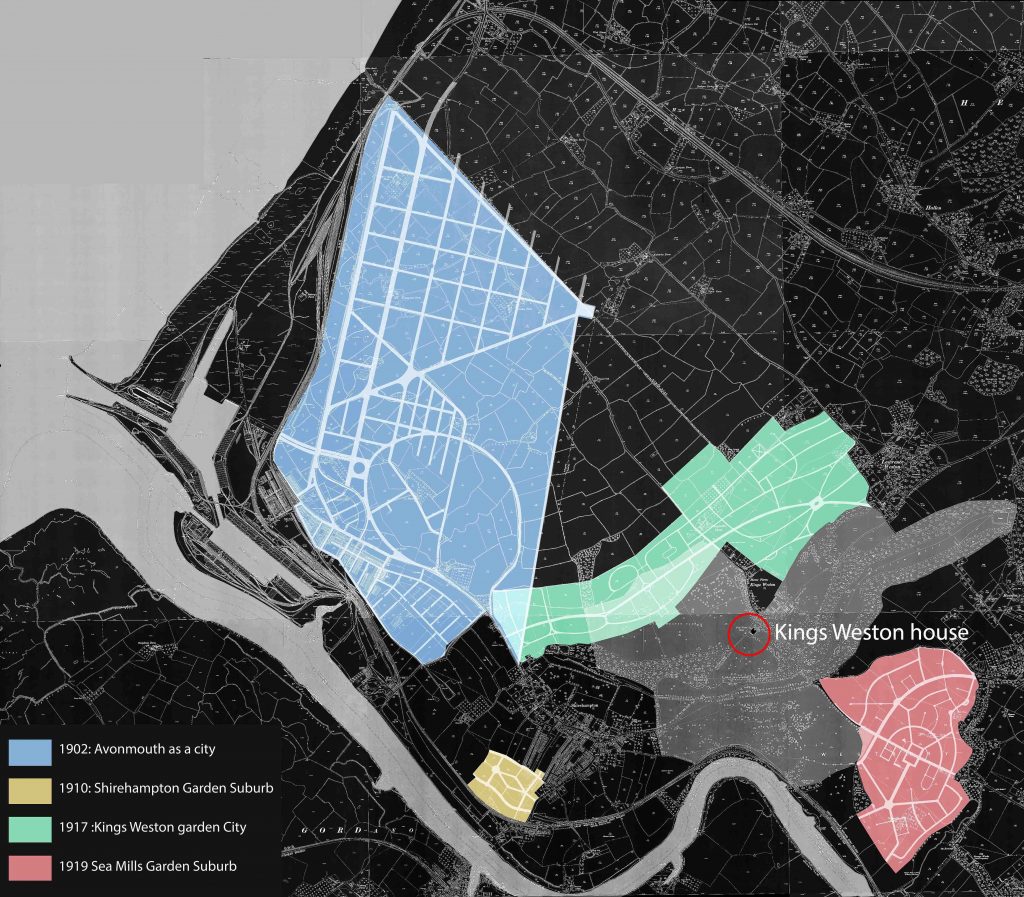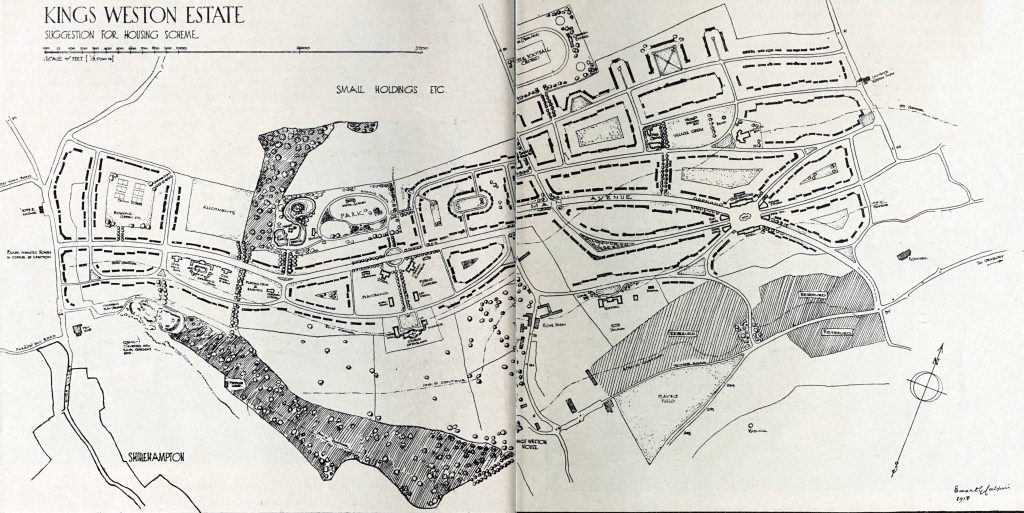Four years ago we wrote a piece on the Garden City aspirations of the last private owner of Kings Weston estate, Philip Napier Miles. Now further evidence has come to light that show his enthusiasm for innovations in town planning and promoting the development of his lands for socially progressive housing
From the moment he inherited the estate from his father in 1881 Napier Miles seems to have been keenly focussed on making the best provision for his tenants and building new homes and facilities for their benefit. Beginning with new streets in Avonmouth he set out some of the best workers housing in the city, before becoming an early adopter of the revolutionary principles of the Garden City movement for new building. The movement promoted the idea that bringing together the best features of the town and countryside would provide the working class with an alternative to farm working or crowded unhealthy cities. All industry, housing, commerce could be provided interspersed with generous greenspace and allotments, and with key facilities to support education and social development.
Miles’s initial project to create a new city around Avonmouth began around 1902 but faltered despite having achieved a lot of high quality new building there. A smaller endeavour was endowed with land at a beneficial rate in Shirehampton in 1910: the Bristol Garden Suburb. Another ambitious plan for development was promoted by Miles in 1917 for the land immediately below Kings Weston house where the Lawrence Weston estate lies today. The main emphasis of the plan was to provide urgently needed housing for labourers at the recently built national Smelting Company zinc works in Avonmouth, and serve the urgent wartime demands. A Public Utility Society was created in partnership with the management of the zinc works, Ernest Bevin of the Dock Worker’s Union, Napier Miles, and other local dignitaries and business owners formed a committee.

On the 15th May the committee met to discuss plans. Napier Miles provided a venue for a meeting between interested parties, under one of the giant beech trees in the garden of Kings Weston house. Ewart Culpin of the Garden City & Town Planning Association, a figure of national importance, provided a sketch layout of a 271 acre estate which, it was projected, could accommodate around 2000 homes for up to 150 thousand people. The plan was set out on Garden City principles with emphasis on green spaces totalling around 60 acres, and tree-line avenues, along a central spine road that approximated todays Long Cross. Progressive public and social facilities such as communal kitchens, wash houses, & laundries were designed in, along with land for a Trades Hall, schools and a hospital. On the western part of the estate were planned the social and educational centre, the church, schools, and other public buildings. A theatre, concert hall, Swimming pools gymnasium & allotments were also projected. It was described as having “more of the elements of a real garden city than in any other proposal since Letchworth”

Co-operation was an imbedded feature of the organisation. Tenants were to become shareholders in the scheme with a vested interest in the estate. Napier Miles “in alluding to his sympathy with this movement, said he had strongly opposed the erection of buildings of such a nature and would in a few years become slums” and the design of new houses ensured good space, light, and access to generous gardens.
The following year the first of the new houses had been completed at the far west end of the estate on Kingsweston Avenue. These were built with the financial support of the Ministry of Munitions who had large mustard gas factories and shell production at Chittening, the National Smelting Company having to step-in in 1919 to complete 150 of the dwellings. These dwellings were more utilitarian than most Garden City architecture, possibly through the necessities of the wartime situation, but enjoyed being interspersed between the existing mature trees of the estate, and were well built and spacious. Stone was supplied from a reopened quarry on Penpole Point and brick from sand dug nearby. The quarry was to become a rock garden in the final scheme, and the cavity left by the sand pit a swimming pool.

After the cessation of hostilities, and the closure of the mustard gas factory, the urgency of the endeavour dissipated. The ambitious plan set out across the whole of the Kings Weston parkland was quietly abandoned only part realised, like Napier Miles’s previous Garden city projects. By this time his interest had already been diverted to Sea Mills where Bristol Corporation sought to develop their own garden suburb on his land, and the development of the Kings Weston Garden City was quietly dropped. What had been built was eventually purchased by the council in 1924.

As a postscript to the Kings Weston Garden City plan, it’s interesting that after the end of WWII attention focussed again on the area, and new plans drawn up that were not dissimilar from those of 1917. Certainly the outline plan of an elongated estate, covering a similar area to Culpin’s original plan were closely comparable, along with the general alignment of some roads. The ambition to provide high quality workers housing, with generous green space and well-integrated community and social facilities was also fundamental to the Council planner’s proposals, though regrettably without the swimming pool, theatre, and hospital that were intended to augment the original plan!
A copy of a contemporary 1918 account of the Garden City can be viewed here: https://mcusercontent.com/d6754e0d3b18e9a31be2d62e5/files/df84c99a-aefe-509b-d2e6-7a0e1dfb2210/Binder1b.pdf











